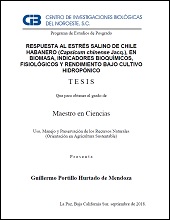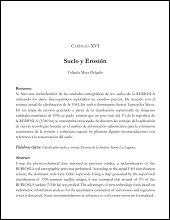Respuesta al estrés salino de chile habanero (Capsicum chinense L.), en biomasa, indicadores bioquímicos, fisiológicos y rendimiento bajo cultivo hidropónico
Texto completo PDF:
Autor
GUILLERMO PORTILLO HURTADO DE MENDOZA
Metadatos
Mostrar el registro completo del ítemResumen
"Se evaluó la respuesta de chile habanero (C. chinense) cv. Chichen Itzá al estrés salino en un sistema hidropónico, dado por cuatro niveles de salinidad (6.6, 9.4 y 13.6 dS m-1) y dos fuentes de sal (NaCl y agua de mar), mediante la evaluación de parámetros morfométricos, fisiológicos, contenido mineral en tejido foliar y la respuesta bioquímica antioxidante. Se encontró que las variables morfométricas y de crecimiento (biomasa seca en raíz, tallo, hoja, fruto, área foliar, tasa de crecimiento y relación vástago raíz) disminuyeron en los niveles de salinidad más altos de 9.4 y 13.6 dS m-1 en ambas fuentes de salinas. Por otra parte, se encontró que las variables para evaluar la respuesta fisiológica como la fluorescencia de clorofilas (SPAD), conductividad estomática y la concentración de CO2 intracelular, presentaron diferencias por la concentración de sales, mientras que la tasa fotosintética y la tasa de transpiración no mostraron respuestas ante los niveles de salinidad evaluados. La concentración de minerales en el tejido foliar mostró que el contenido de sodio fue mayor en los tratamientos donde la fuente de salinidad fue NaCl en comparación con los tratamientos con agua de mar. De forma general, se encontró que el contenido de potasio disminuyó a medida que el nivel de salinidad aumentó. No se observaron diferencias significativas entre el nivel más bajo de salinidad (6.6 dS m-1) y el tratamiento control. La interacción de los niveles de salinidad y la fuente salina mostró diferencias significativas para el contenido de sodio, potasio, magnesio y calcio, mientras que la relación de sodio/potasio, sodio/calcio, sodio/magnesio mostró diferencias estadísticamente significativas. Los resultados de la defensa antioxidante enzimática en tejido foliar indican que hay diferencias estadísticamente significativas para la actividad de SOD para el factor de conductividad eléctrica, presentando mayor actividad a 13.6 dS m-1 con NaCl como fuente salina; la actividad de POX se incrementó en el nivel de salinidad de 6.6 dS m-1 de las soluciones a partir de NaCl y agua de mar respectivamente. La peroxidación de lípidos aumentó debido al nivel de salinidad, alcanzando su valor máximo en 9.4 dS m-1 de la solución con NaCl. El contenido de capsaicinas en el pericarpio de los frutos, en los niveles de salinidad de 6.6 dS m-1 no mostraron diferencias respecto al grupo control..." "The response of habanero pepper (C. chinense) cv. Chichén Itzá to salt stress in a hydroponic system, given by four levels of salinity (6.6, 9.4 and 13.6 dS m-1) and two salt sources (NaCl and seawater), through the evaluation of morphometric parameters, physiological, mineral content in foliar tissue and the antioxidant biochemical response. The morphometric and growth variables (dry biomass in the root, stem, leaf, fruit, leaf area, growth rate, and root stem ratio) were found to decrease in the highest salinity levels of 9.4 and 13.6 dS m-1 in both sources of salinity. On the other hand, the variables to evaluate the physiological response such as chlorophyll fluorescence (SPAD), stomatal conductivity and intracellular CO2 concentration, shows differences by the salt concentration, the photosynthetic rate, and the transpiration rate don’t show differences to the salinity levels evaluated. The concentration of minerals in the foliar tissue showed that the sodium content was higher in the treatments where the source of salinity was NaCl compared to the treatments with seawater. In general, it was found that the potassium content decreased as the salinity level increased. No significant differences were observed between the lowest level of salinity (6.6 dS m-1) and the control treatment. The interaction of salinity and saline levels showed significant differences for the content of sodium, potassium, magnesium, and calcium, while the ratio of sodium/potassium, sodium/calcium, and sodium/magnesium showed statistically significant differences. The results of the enzymatic antioxidant defense in leaf tissue indicate that there are statistically significant differences for the SOD activity for the electrical conductivity factor, presenting greater activity at 13.6 dS m-1 with NaCl as a saline source. The activity of POX was increased in the salinity level of 6.6 dS m-1 of the solutions from NaCl and seawater respectively. Lipid peroxidation increased due to the salinity level, reaching its maximum value in 13.6 dS m-1 of the solution with NaCl. The content of capsaicin in the pericarp of the fruits at the salinity level of 6.6 dS m-1 did not show differences in comparison to the control group..."
Colecciones
Ítems relacionados
Mostrando ítems relacionados por Título, autor o materia.
-
PROMOCIÓN DEL PERIFITON PARA EL CULTIVO DE CAMARÓN BLANCO: HACIA UNA ACUICULTURA ECOLÓGICA
DOMENICO VOLTOLINA LOBINA; JUAN MANUEL AUDELO NARANJO; MARIA DEL ROSARIO PACHECO MARGES -
Suelo y Erosión
YOLANDA LOURDES MAYA DELGADO


